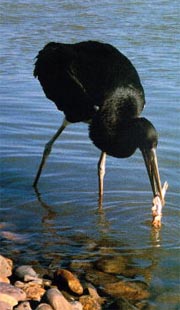| About China > Fauna & Flora > Class I Animals > Aves |
|
|
Black Stork
The bird belongs to the Ciconiidae family of Ciconiiformes
order. Its scientific name is Ciconia nigra (Latin), or
Black Stork
(English).
It is a large-size wading bird, with full body-length of about 110 centimeters. The bird has long and stout beak. The feathers on the upper body, wing, tail and chest are black, with violet green luster. The naked skins round the eyes are red. The portion below the chest is white. The beak and feet are red.
Black Stork inhabits in river banks, morass, or near rivulets in mountainous areas. It feeds on frogs, snakes and crustacean. Breeding begins in April, with nests built in rock cliff apertures or on huge trees. There are 3 to 6 eggs per brood, which are milky white with a few light orange concealed spots. The incubation period lasts 31 to 34 days. Young birds can fly about 65 to 70 days after birth.
It usually propagates in Northeast China, Hebei Province, Xinjiang Uygur Autonomous Region and northern Gansu Province, and moves to the Yangtze River valley and south to the river for hibernation. |
||||
 |
